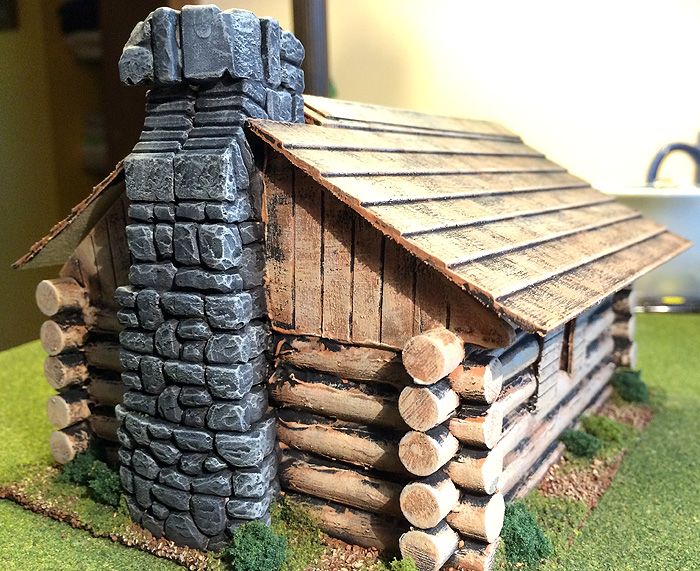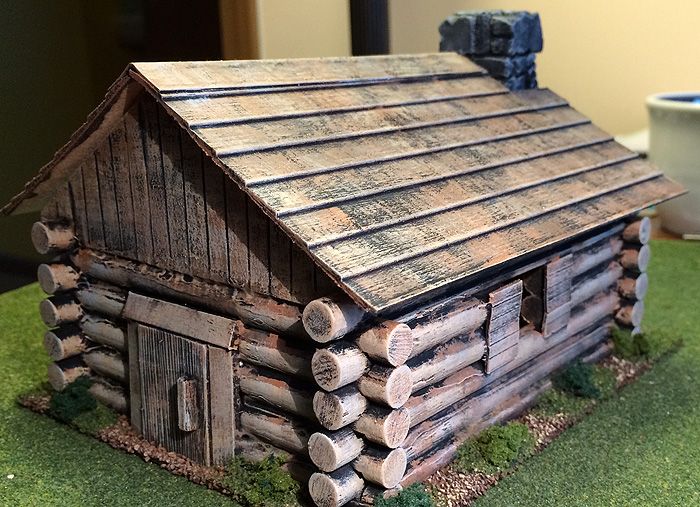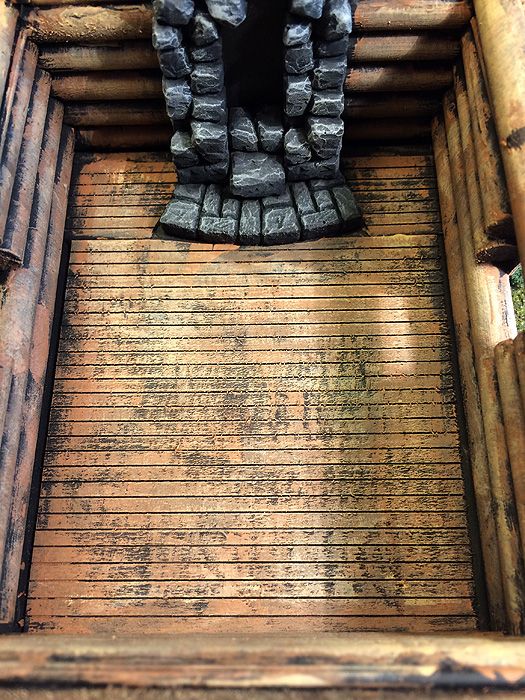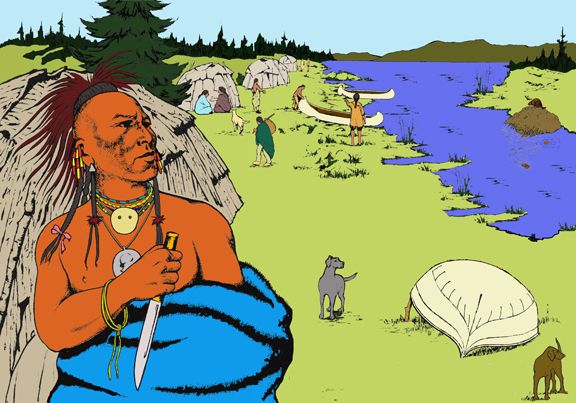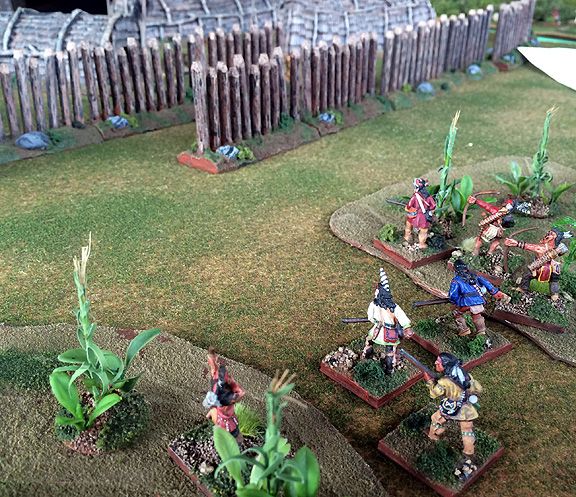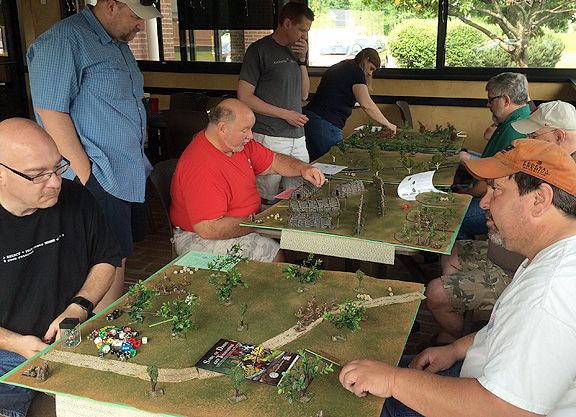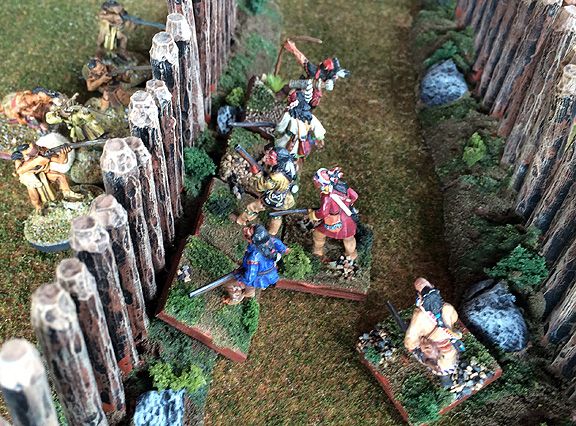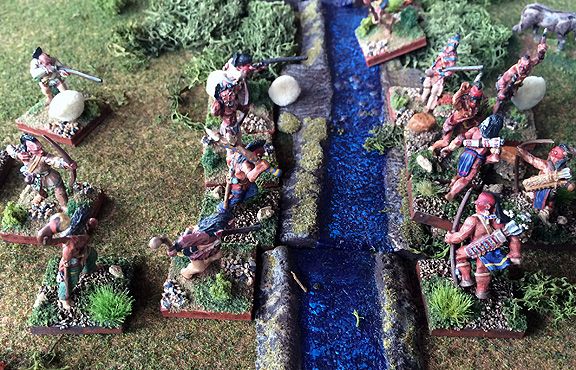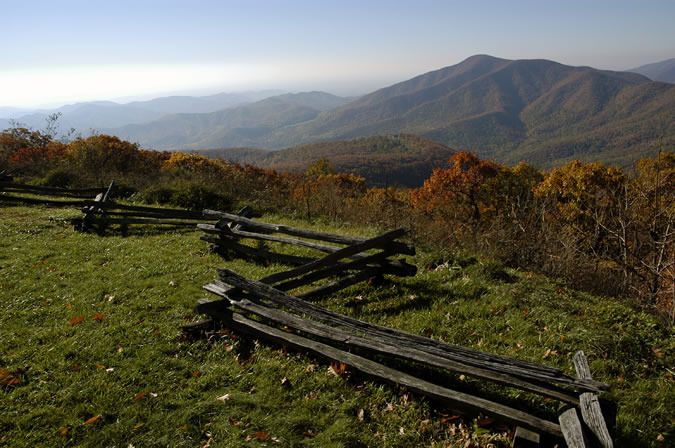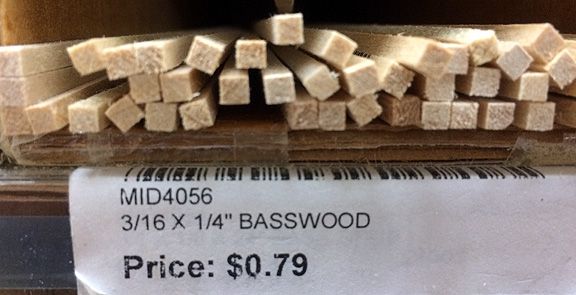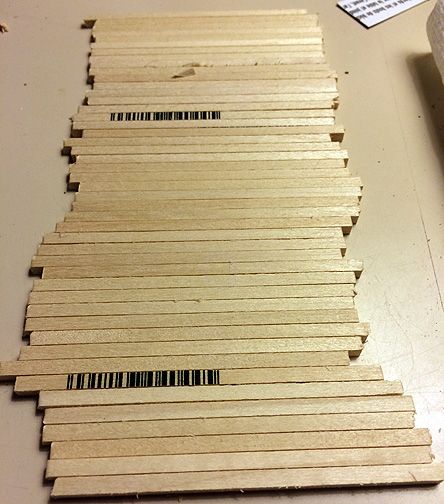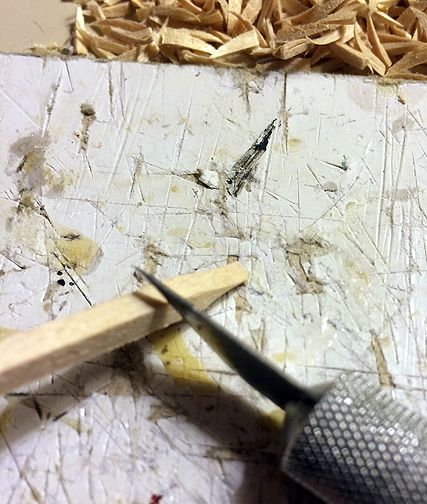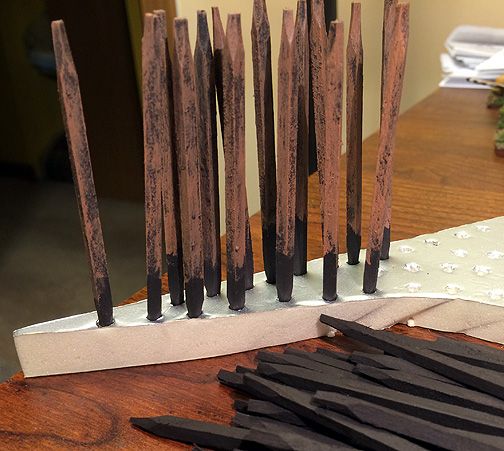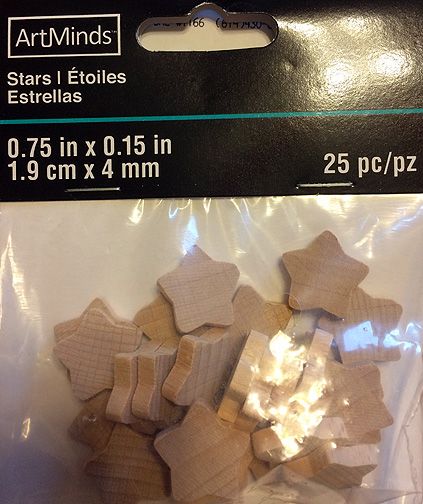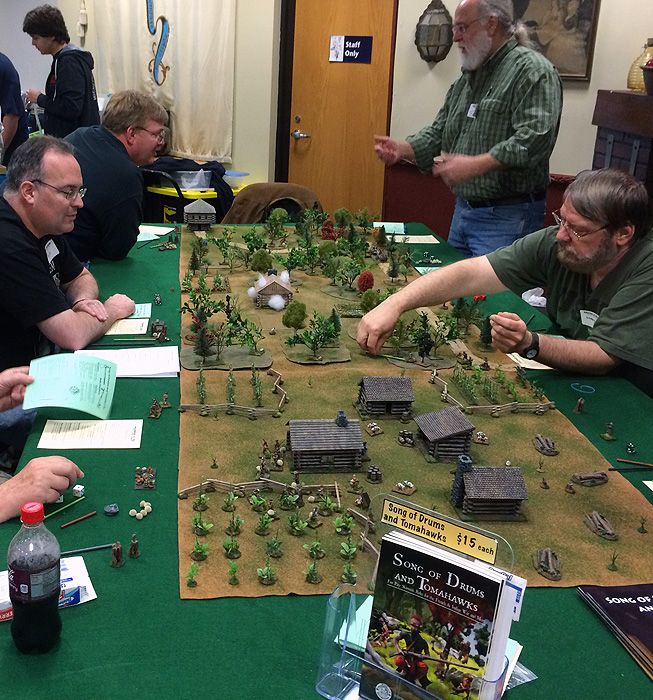 |
| Both of my frontier Indian raid scenarios were full -- including this shot of the Saturday morning session |
I took my multiplayer
Song of Drums and Tomahawks event up to
Drums at the Rapids, a convention held at historic, Fort Meigs, Perrysburg, OH. I have been attending the convention for more than a decade, and it is an excellent local con put on by
HMGS Great Lakes. The focus is historical miniatures, though there are always cool-looking fantasy and science-fiction games, too. I cooked up a new set of linked scenarios. This one would feature Indians vs. frontier settlers, as opposed to the more varied scenario groups I've run in the past.
 |
| An overview of the "Farmhouse Raid" scenario in the opening stages of Friday night's battle (you can see the women and children beginning to run away from the side that the Indians are entering from) |
The first scenario begins with the people of a frontier farmstead community spotting a plume of smoke rising off in the distance. They know that it usually means a raid across the frontier by hostile tribes, so hurriedly debate whether to "fort up" in their cabins, or head to the local blockhouse. Before they can decide, a man runs up and says an Indian warparty is right behind him. The frontiersmen and six women and children deploy in the middle of a collection of four log buildings in the center of the board. The Indians can deploy anywhere on the table, as long as they don't deploy within 1 Long distance (close musket range) of a frontiersman or family member.
 |
| On both days, the Indian player decided to have his raiders enter through one of the cornfields |
I really liked how this table looked, once it was all set up. This was also the table where I had made my scratch-built,
snake rail fences. I used them to create three fields at corners of the boards. Inside the fields were the
JTT corn rows (which I now know I need to make more of...!), along with the
3 Sisters native American crop pieces, and some random bits of vegetation to fill them up. In both the Friday night and Saturday morning sessions, the Indian player chose to enter using the cover of the fields.
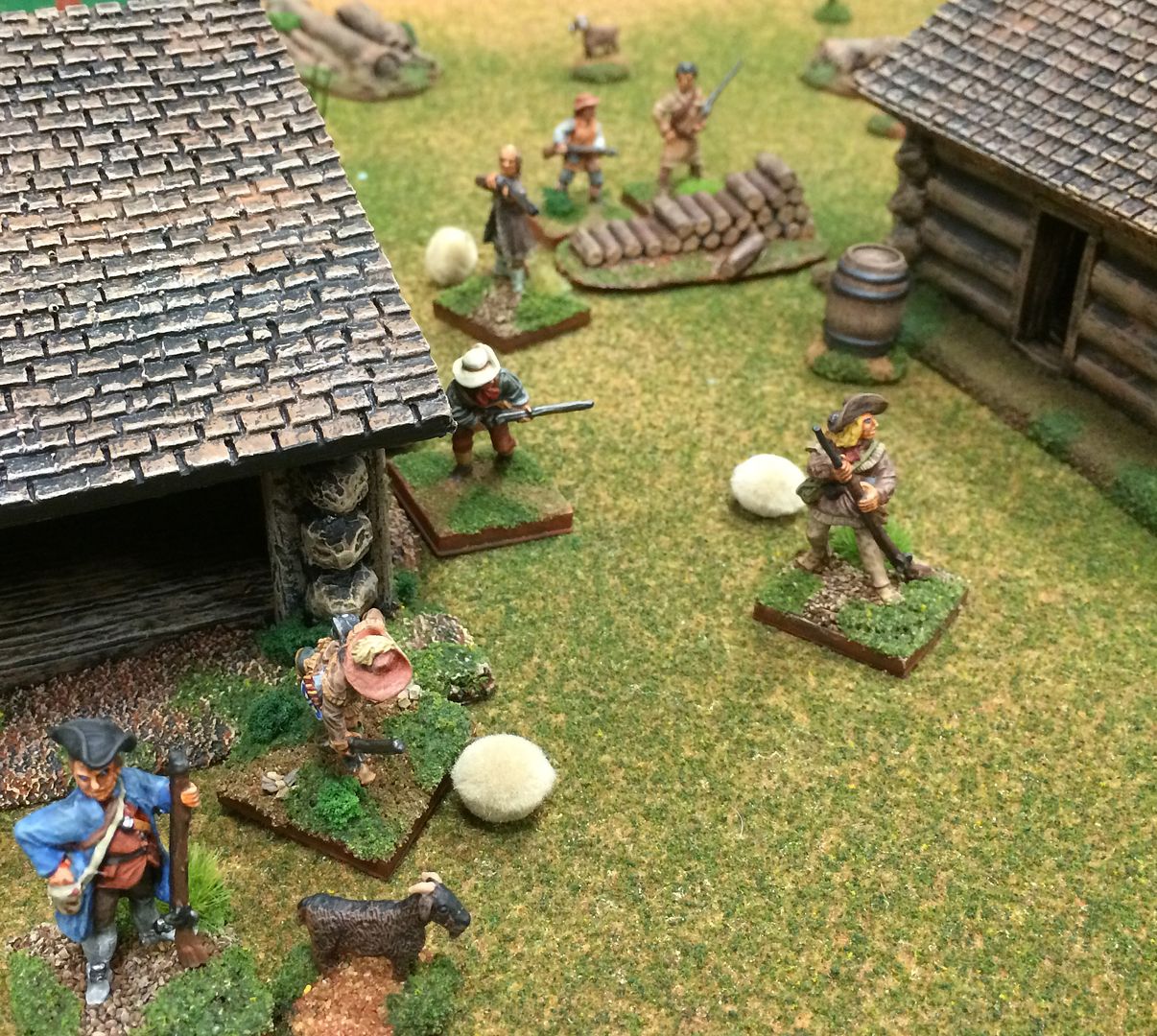 |
| Close up the menfolk of the farmstead community mustered to defend their families (and one brave goat, willing to take his place in the line alongside his owners...ha, ha) |
The two runnings of this scenario had vastly different outcomes, though. Friday night, the frontiersman player chose to take advantage of the fact the Indian warparty came in on one board edge to shuttle the women and children off the opposite edge. If a family member ends the game with no Indians within a Long distance, it is victory points. The menfolk fought a delaying action against the Indian raiders, slowly giving ground and surrendering their homesteads to them. When some settlers began to flee from morale checks, they decided to withdraw to prevent further losses. The result was more homesteads up in flames, and Indians in possession of scalps and loot.
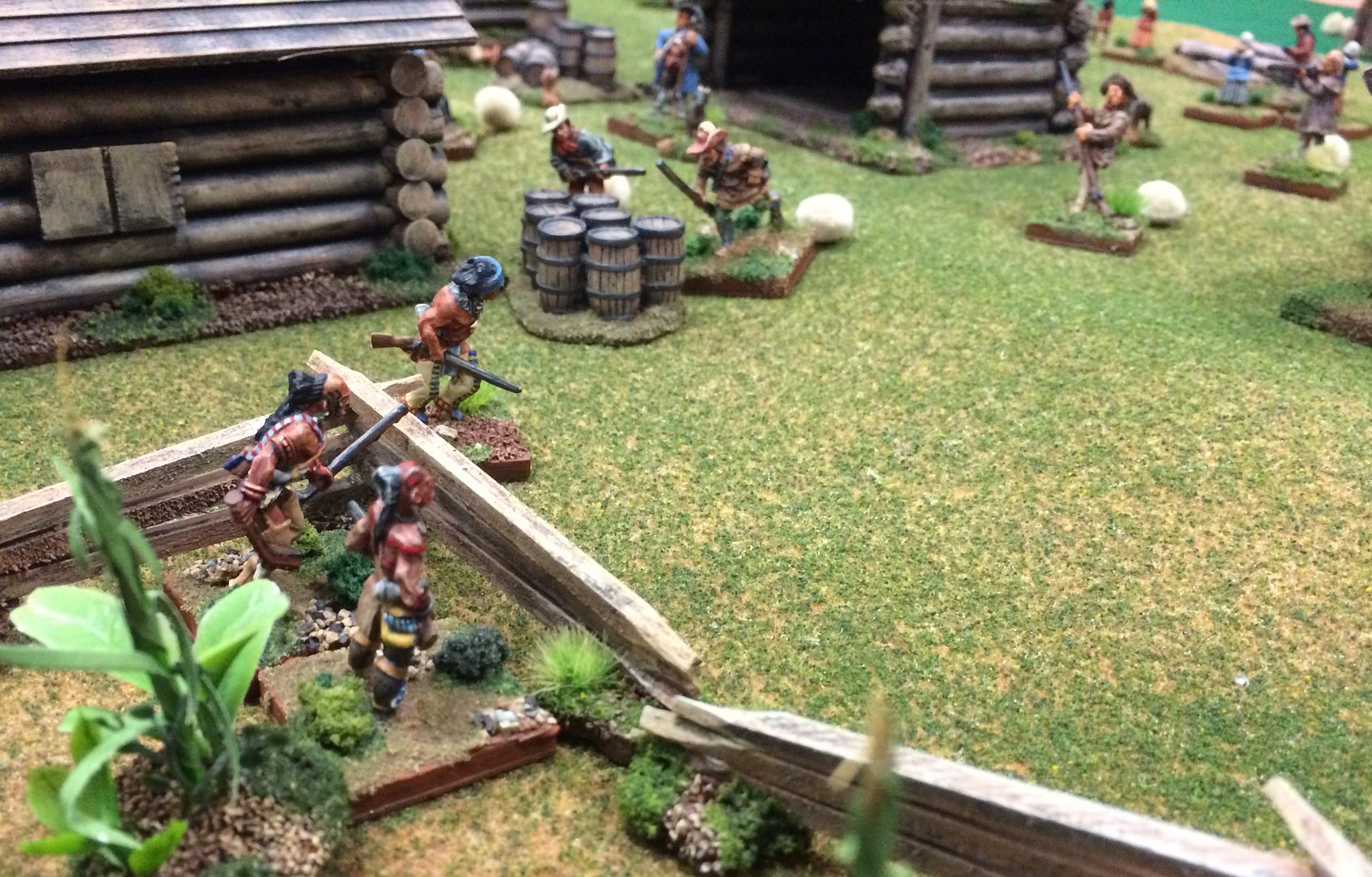 |
| The fighting was at close range and brutal. Here Indians and settlers struggle for control of the center of the farmstead |
Saturday morning saw a much more aggressive frontiersman player. She put the women and children inside the cabins and had the menfolk launch an assault on the Indian raiders. Losses piled up on each side, but the Indians broke first. Before long, the settlers were victorious and had chased the raiders off of their hard-won land.
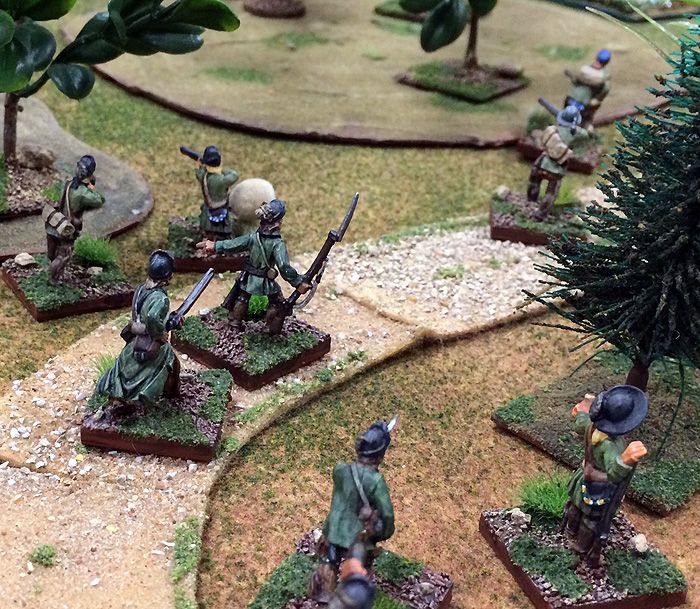 |
| A patrol of rangers investigates the plume of smoke in "They Died in the Smoke" |
The middle scenario on the 9'x3' table layout was where that original plume of smoke was originating from. Here, the family spotted the Indians at the last moment and fled into their house, bolting the door. At each window, a musket poked through and fired when any Indians ventured out into the cleared area surrounding the cabin. Fire arrows were shot onto the roof of the cabin, and soon the home was ablaze. Smoke filled the cabin and poured out the windows. However, the family refused to come out and die under the tomahawks of the raiders. Suddenly, the one of the braves spotted a ranger patrol hurrying to the spot to determine the source of the fire.
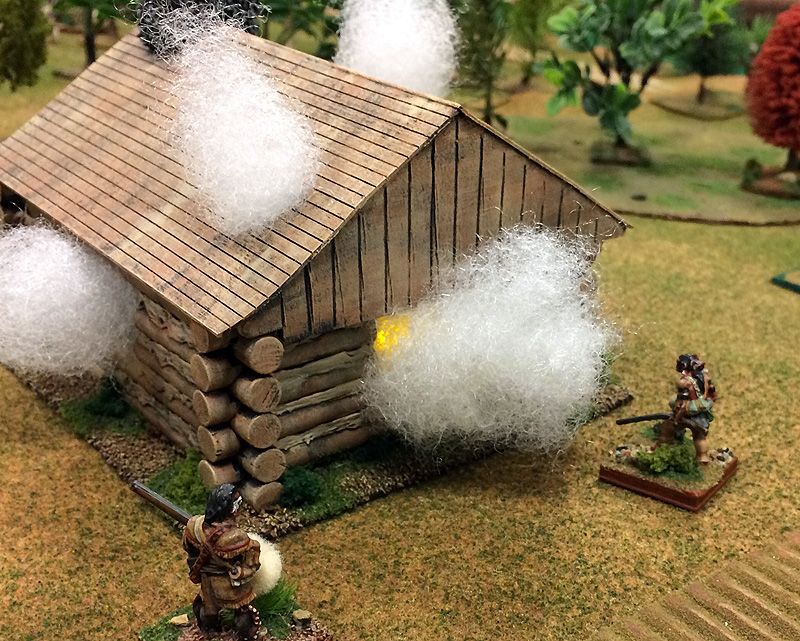 |
| Indian raiders wait in vain for a family of settlers to come out of their burning cabin |
For this scenario, I constructed a special "burning cabin." I used one of the
Darice Premium Wood Model log cabin sets that are available at Hobby Lobby for only $3.99. I modified this one by sawing through some of the dowels to have actual openings for windows. I used a corrugated pattern balsa wood sheet for the roof, which I also cut holes into to represent areas disintegrating in the flames. I placed two electric LED votive candles inside the cabin to light up the smoke with their flickering yellowish light. Acrylic "batting" (pillow stuffing) was cut and placed in the windows and protruding out from the roof. I am only moderately pleased with the results. Of course, I was hurrying to get it done in time for the convention, so I intend to go back and tweak it some.
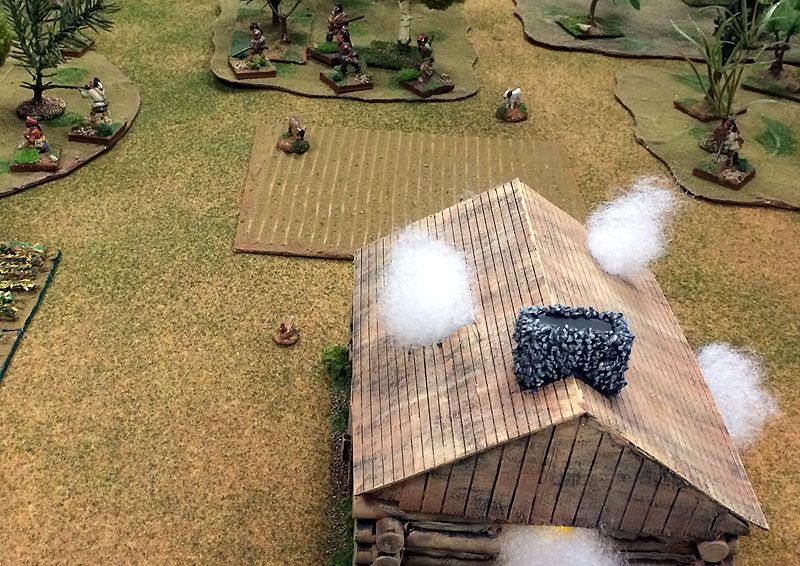 |
| The Indians begin the scenario deployed in the woods in an arc around the cabin |
Once again, I had two vastly different outcomes in this scenario. The Indians begin deployed in a woods in an arc around the burning cabin. The rangers enter through the corner of the board where a pathway runs through the forest. I was particularly surprised by the Indian player's choice to deploy part of his force very close to the ranger entry point. Since about 1/3 of them would be scattered far away around the clearning, I felt this could go very bad for him as he faced the full force of the rangers. One of the things I like about
Song of Drums and Tomahawks is that player decisions have a major impact and drive the game. How many times have we sat down for a miniatures game to find the only decision we could make was to move forward and roll dice? These rules definitely are NOT that, and the player is constantly called upon to make tactical decisions that impact the game in a major way.
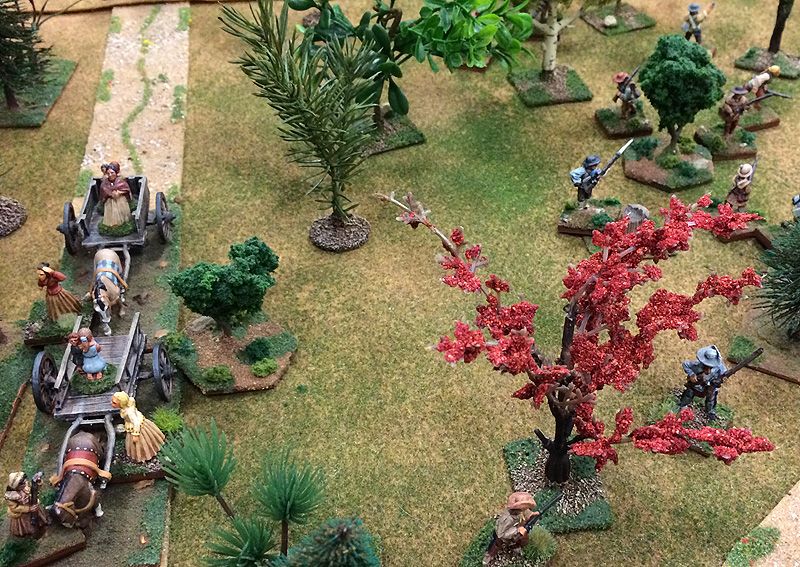 |
| A family hurries to the local blockouse, women and children aboard wagons, while the men scour the woods alongside, searching for ambushing Indian raiders in "Wagon Train Through Peril" |
As it was, the aggressive Indian player was rewarded for his decisions when the ranger advance proved tentative and was halted by poor die rolls. The battle was very one-sided, and the rescuing rangers were quickly whittled down by Indian musket fire. The survivors bravely attempted to maneuver around to reach the cabin, but soon the last remaining ones were driven from the field. The previous night, the opposite was true for much of the battle. It was the Indian player who was hampered by his poor die rolls, and could not collect his forces together to oppose a much more aggressive ranger advance. In fact, the Indian force, though causing casualties among the Rangers, soon was fleeing backwards due to morale checks. However, here is where the tide shifted. The core of remaining Indians fought back aggressively. Soon, they had whittled the rangers down to where they were fleeing backwards in morale checks. It proved to be a nail-biter of a game, with the Indians very narrowly triumphing.
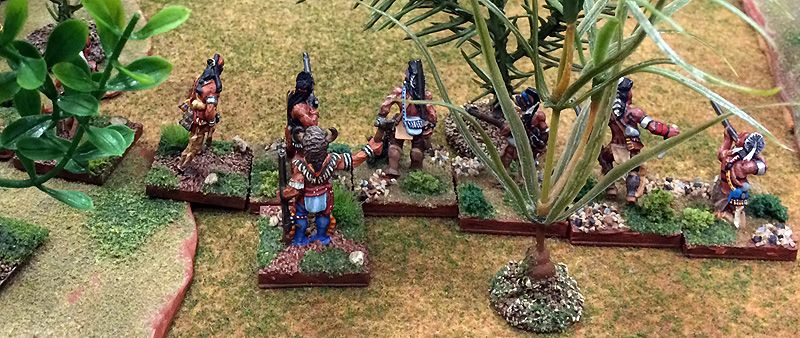 |
| Waiting for the family, in the trees is a line of Indian raiders. When they see the wagon, they close in. |
The third scenario was a variant on one I have run for several years. Having seen the plumes of smoke, a family is hurrying for safety towards a local blockhouse. In this version, there are a substantial number of men escorting the wagon. The blockhouse, on the other hand, is only weakly guarded and can send no rescuing force. The family must fight through any Indians they encounter on the way on their own. A couple special scenario mechanics enable the wagons to move on their own, as long as family members are there to drive them. Also, if any Indians enter the clearing surrounding the blockhouse, they can be shot at (one per turn) by the defenders. They will not waste powder on shots in the woods, as they don't know how long the siege will last.
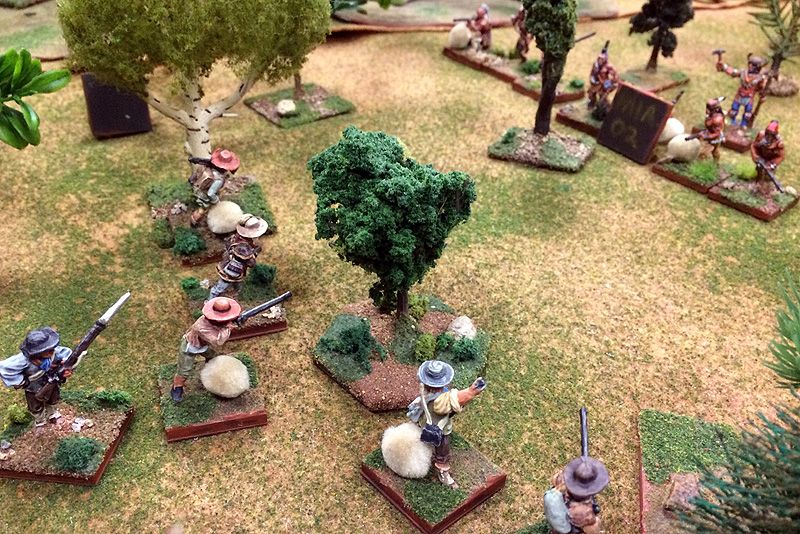 |
| The male family members trade shots with the ambushing Indians, trying desperately to drive them off so their family can reach the blockhouse |
Both nights provided a tense, gripping game. The one on Saturday morning was particularly tense, though. It swung back and forth, with the settlers having the upper hand one moment, and the Indians the other. On Friday night, the wagons came close to making it through to the blockhouse, but did not. However, on Saturday morning, they actually made it all the way to the clearing before losses piled up enough to cause morale checks. One interesting feature of my side-by-side scenarios is that players can reinforce neighboring battles if they have driven the enemy from the field in their own. With the rangers being chased off relatively early in the Saturday morning game, a fresh force of Indians was able to appear on the edge of this field.
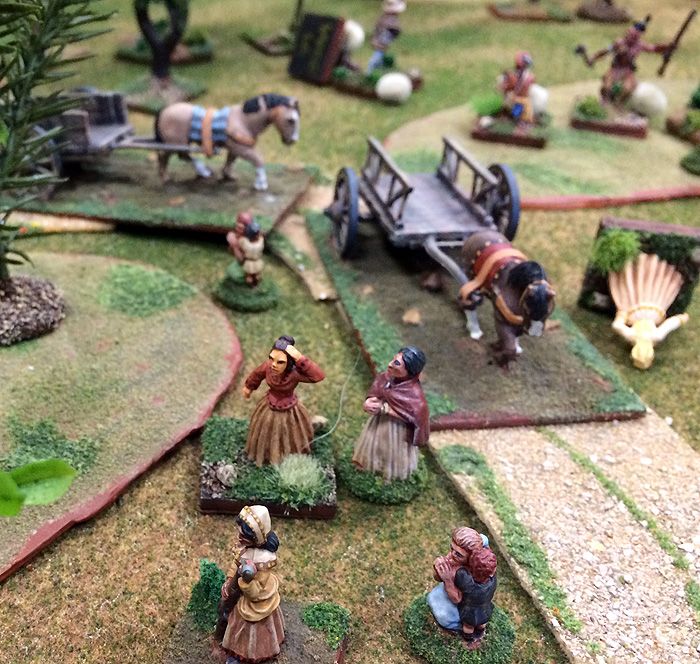 |
| At the sight of one too many of their menfolk slain, the women and children abandon the wagons and flee on foot towards the safety of the blockhouse |
The family proved stalwart, though. They had broken the morale of the ambushing Indians and driven most of them from their path. Three menfolk of the family bravely stood and barred the advance of a new warparty of seven Indians, who had been drawn by the sound of the gunfire. In particular, one man whom the Indians called "Yellow Hair" slew many warriors before finally succumbing to a musket ball. Equally heroic, the leader of the ambushing Indians ran forward and grabbed the reins of the lead horse. Two family members attacked him, but he slew one, which broke the morale of the family. Most of the women and children leaped off of the wagons and sprinted for the blockhouse. A few of the men also bolted for safety, while others remained to fight off the Indians.
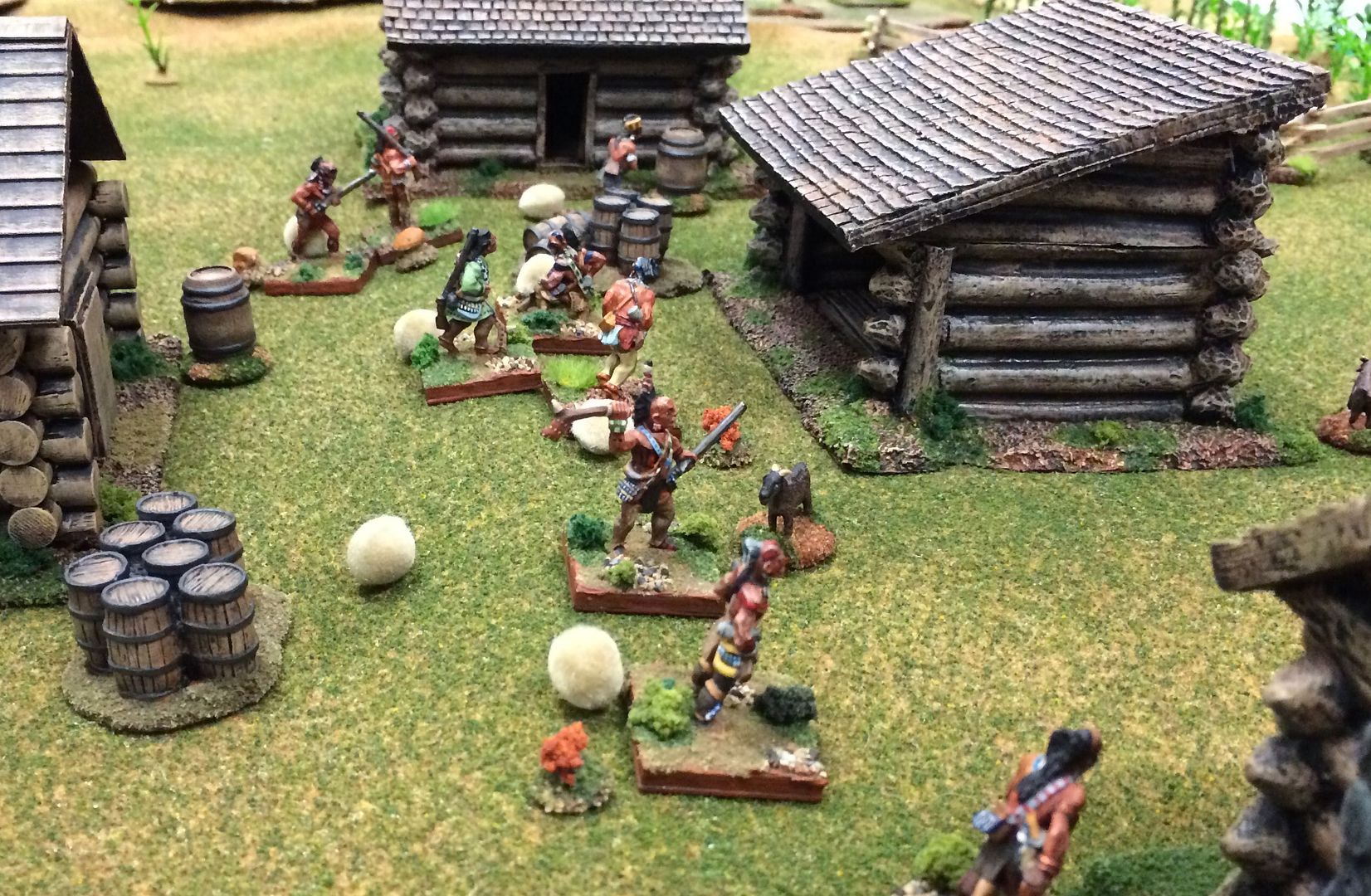 |
| Indians triumphant! One day saw an Indian victory, and the other a Settler one, but good games all around! |
Just when you'd think the battle could show no more twists, the family members killed enough from the warparty to have them check morale, too. They proved eager for battle, though, and only one warrior fled the vicinity. Meanwhile, the women and children were streaming closer to the blockhouse. The Indians closed in, and only about half of them made it before they were caught. It was a relatively long game of
Song of Drums and Tomahawks -- prolonged, of course, by the arrival of 7 fresh warriors from the neighboring battlefield. It was certainly one of the most gripping I'd watched (or played). Everyone who'd played in the games enjoyed them, though, so it was another successful pair of convention events. My next games will likely be at Historicon (I need to sign up for them ASAP). I will also be running games at the local
Ohio History Center as part of their Ohio's March Through Time event.
